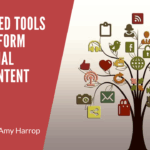 For the past several years, content marketing has remained the best way to promote yourself and your business.
For the past several years, content marketing has remained the best way to promote yourself and your business.
However, that doesn’t mean that nothing changes. The world of content marketing is always evolving. For me – and for anybody who’s building a business – it’s important to stay on top of the latest trends. If you don’t, you might find that the content you work so hard to create doesn’t get the attention it deserves – or earn the money you want it to earn!
With that in mind, here are the content marketing trends to capitalize on for the rest of this year and beyond.
Topic-Focused Content
Perhaps you’ve noticed that some authority sites have multiple blog posts and other kinds of content that focus on the same general topic. Such content might seem repetitive, but it serves a purpose. Specifically, it builds authority.
Topic-focused content focuses on topic clusters. For example, I have been writing a series of blog posts about how to create and market printables. While there is some overlap between posts, each post looks at the topic from a different angle or with a different goal in mind. The cumulative effect of these posts tells Google that I am an authority on printables marketing.
A related content marketing trend is the use of pillar pages, which provide a long-form overview of a topic and link out to related pages on the same website. They’re a great way to build internal structure on your site and give visitors an incentive to stick around and read your other content.
Streaming and Live Video
Video marketing and live streaming aren’t new, but their importance is increasing and will continue to grow throughout 2020.
The numbers don’t lie. Video content gets more engagement on Instagram than any other content. Likewise, 72% of consumers say they prefer to learn about a product or company by watching a video. Experts say that by 2022, 82% of all online traffic will be video-driven.
Streaming is a newer phenomenon than video, but its growth is extraordinary. By 2024, it’s anticipated that the streaming video market will grow to more than $124 billion worldwide.
With the rise of Facebook Live, YouTube Live, and a host of online streaming services, it’s easier than it ever has been to shoot and stream live video to your followers. One of the benefits of live video is that it doesn’t need to be as polished and scripted as a formal marketing video. People expect live video to be conversational and informal – and that makes it fun to create live video.
Podcasts
Podcasts are a good example of something (kind of) old that’s somehow new again. While the first podcasts arrived in 2004, their popularity has exploded in the past few years. To give you an idea of what’s happening in the market, here’s just a small sampling of the platforms where you can find podcasts to listen to:
- Audible (their Audible Originals often included fiction and non-fiction series even though they don’t call them podcasts)
- Google Play Music
- Spotify
- Pocket Casts
- Apple Podcast
Podcasts can be non-fiction or tell a story. You can find podcasts on almost any topic. You might think you need a professional recording studio to record a podcast, but the truth is that you can do it with minimal equipment.
Creating a podcast about a topic can help you build authority and connect with your target audience.
Conversational Marketing
The rise of voice search and artificial intelligence has affected the way we look at content marketing. One way that the changes have manifested themselves is in the use of conversational marketing, which talks directly to customers to engage them in conversation about products and services.
Chatbot marketing is one clear example of conversational marketing. You may have noticed an increase in the number of sites that use chatbots. They usually appear as a pop-up dialog box that asks a question or offers to help visitors with an issue.
While this might not seem like the content marketing you’re used to reading about, every chatbot interaction is scripted and created with the goal of helping a business retain an existing customer or attract a new one.
I’m still thinking about ways to incorporate conversational marketing into what I do, and I encourage you to do the same. It’s a trend that’s likely to continue.
Personalization and Dynamic Content Delivery
The last trend I want to talk about is personalization. Increasingly, people who shop or seek out services online expect to have direct and personal interaction with businesses – and that includes publishers.
Your personalized marketing could be in the form of email marketing, which continues to perform well. Personalization in emails can be simple. For example, you might create emails that use the subscriber’s first name in the greeting. You can also segment your email marketing list to include personalized discounts and offers tailored to a subscriber’s tastes.
Dynamic content is a form of personalized marketing that involves creating content that changes according to someone’s behavior or interests. You can use dynamic content by:
- Allowing visitors to your site to choose the topics that interest them.
- Allowing email subscribers to select the emails they want to receive from you.
- Creating pop-ups and changing content based on what visitors to your site do. One example would be creating a pop-up window that offers people a chance to opt-in for a free piece of content once they’ve been on your page for 5 minutes or read 50% of its content.
Creating this kind of content can be easy or complicated. A complex example would be the algorithm that decides which content to display on each user’s Facebook feed. However, you don’t need to be a math or programming whiz to use dynamic content in your marketing.
Conclusion
Content marketing trends come and go, but I think it’s safe to say that the trends I’ve outlined here are going to play a big role in marketing in 2020. I hope you’re inspired to try some (or all) of them to grow your business!




Leave a Reply